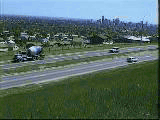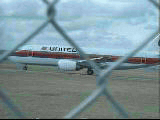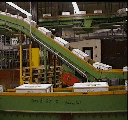 1. The Cement Truck
1. The Cement Truck
 1. The Cement Truck
1. The Cement Truck
A cement truck is moving slowly along a busy roadway. There are vehicles moving more quickly in the same direction and also in the opposite direction, as shown in the input cement truck sequence (160x120, 100 frames, 330K). We are able to design a 3-D filter to pick out only vehicles moving at the speed and direction of the cement truck, as shown in the output cement truck sequence (160x120, 100 frames, 142K).
 2. The Taxiing Aircraft
2. The Taxiing Aircraft
A second example has an aircraft taxiing along a runway at Calgary International Airport. The camera is panning with the aircraft, but behind a chain link fence which moves across the image obstructing the view of the aircraft, as shown in the input taxiing sequence (160x120, 100 frames, 215K). We are able to design a 3-D filter to eliminate the fence allowing an unobstructed view of the aircraft, as shown in the output taxiing sequence (160x120, 100 frames, 149K).
For a somewhat more detailed description of the above Linear Trajectory filtering, please consult Norm Bartley's home page.
Here is an example of using adaptive 3-D filtering techniques to track and enhance an object that moves on a curved trajectory.
 Two moving objects
Two moving objects
The test input sequence (100x100, 32 frames, 16K) consists of two objects that move along intersecting helical trajectories. We wish to lock onto, and track, one of these objects in the presence of severe noise. In the noise-contaminated sequence (100x100, 32 frames, 217K), neither of these objects should be visible. The adaptive 3-D filter is able to locate the object of interest, and to track and enhance it, as shown in the filtered output sequence (100x100, 32 frames, 21K)
Please have a look at Norm Bartley's home page for more details.
Here is an example of using M-D filter hardware-simulation software to examine quantization effects in a particular implementation of a Linear-Trajectory (LT) filter.
 Beer cases
Beer cases
One of the critical parameters in filter hardware implementations is data wordlength, which determines the precision and dynamic range of the signals. Choosing a too-short data wordlength can result in filter instability; choosing a too-long data wordlength makes the hardware too expensive.
The input sequence (256x240, 53 frames, MPEG, 499k) was filmed at a local brewery. Note that it contains several objects moving with different velocities.
A filter structure capable of implementing a LT filter was designed, and the coefficients were tuned to pass the diagonally-moving beer cases. In order to investigate the effects of changing wordlength, a simulation (256x240, 53 frames, MPEG, 120k) of a 16-bit hardware implementation of this filter was performed, and the filter was found to perform very well. However, a simulation (256x240, 11 frames, MPEG, 44k) of an 8-bit implementation showed that filter becomes unstable.
For more details, please see MultiDimensional Network Analysis Program.